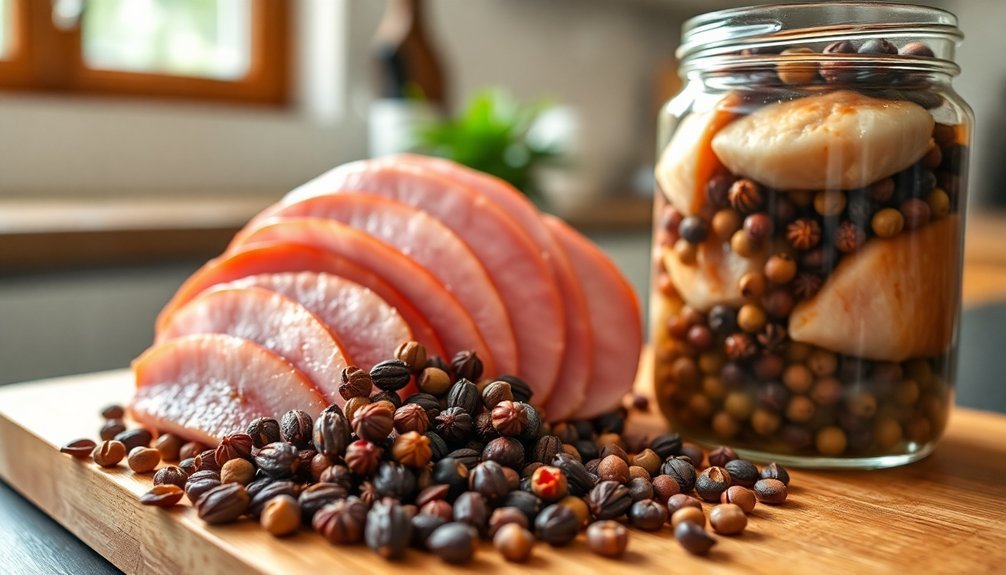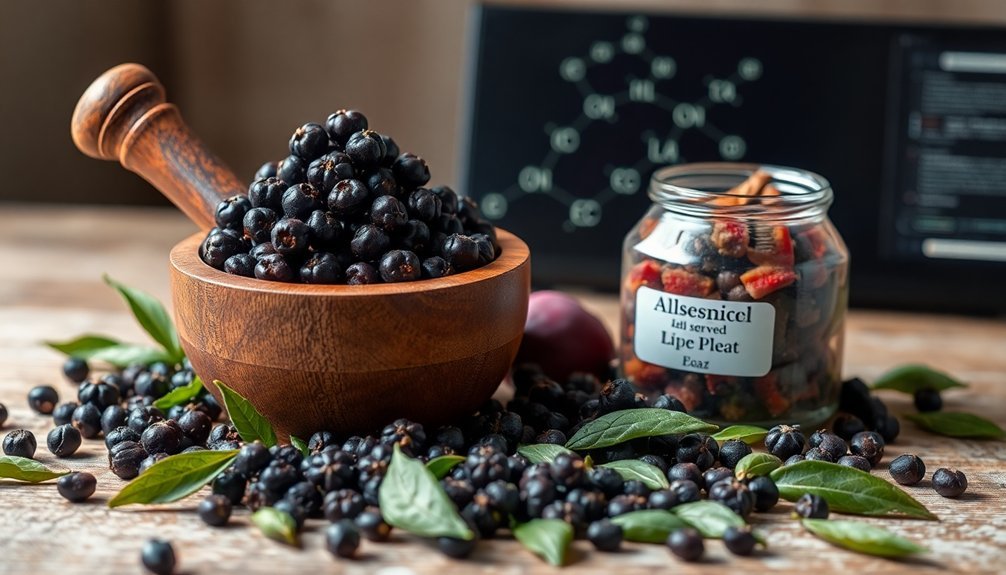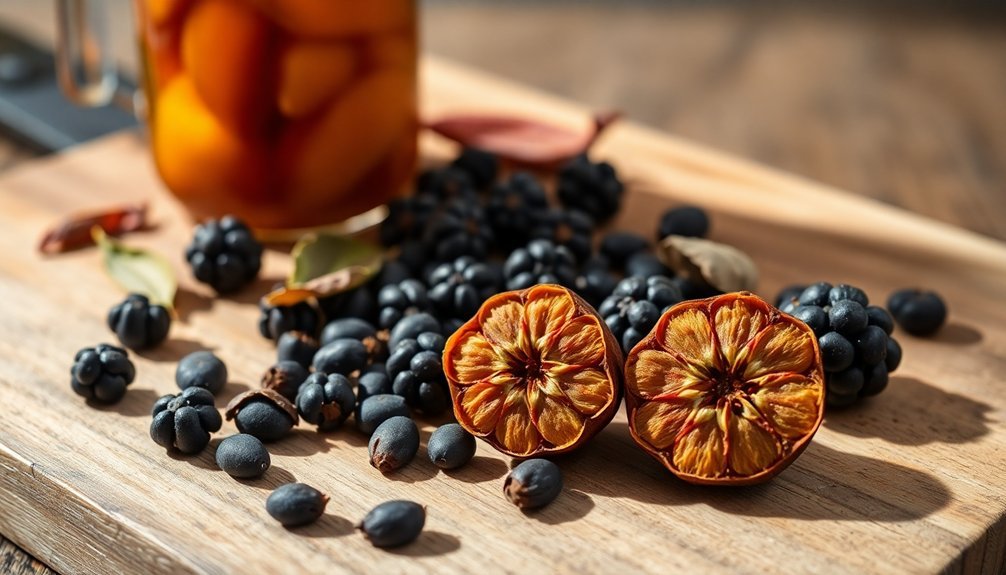Allspice keeps your food fresh longer thanks to its powerful natural compounds, especially eugenol and myrcene, which make up nearly 80% of its essential oils. These compounds actively fight harmful bacteria by disrupting their cell membranes and preventing growth. You'll find it's particularly effective at preserving meat and dairy products because it slows down fat oxidation and acts as a potent antioxidant, with 90% radical scavenging activity that surpasses many synthetic preservatives. Its dual action as both an antimicrobial and antioxidant agent makes it a time-tested preservative that's been trusted since ancient civilizations. There's much more to this remarkable spice's preservation power than meets the eye.
Ancient Roots of Allspice Preservation

The fascinating history of allspice preservation dates back to the late 15th century when Christopher Columbus first encountered this versatile spice during his second voyage to the New World.
During this period, you'd find ancient Greeks and Romans already using similar spices for food preservation, though they weren't familiar with allspice specifically.
When Spanish explorers introduced allspice to Europe in the 16th century, they discovered what indigenous Caribbean people had known for generations: this remarkable spice could help keep food fresh longer.
The Arawak and Taino peoples used this spice extensively for preserving their meats before European contact.
You'll find that the proper drying process was essential to maintaining the spice's preservative properties. The berries were picked while green and unripe, then carefully dried to retain their volatile oils, which are vital for preservation.
If you're storing allspice today, you'll want to follow traditional practices that have proven effective over centuries.
Keep your allspice berries whole rather than ground, as they'll maintain their preservative qualities longer.
You can still find allspice used in modern food preservation methods, from pickling to sausage-making, carrying forward techniques that originated with ancient civilizations and were refined through colonial trade networks.
Natural Antimicrobial Power
When you look at allspice's natural power to fight bacteria, you'll find eugenol as its star antimicrobial compound.
Through its essential oils, allspice targets bacterial membranes, breaking them down and ultimately causing bacterial death.
You can see this bacteria-fighting action especially against common pathogens like E. coli and Salmonella, making allspice a powerful natural food preservative. Allspice contains other beneficial compounds like ericifolin and quercetin that enhance its preservative abilities.
Bacteria-Fighting Essential Oils
Essential oils represent nature's powerful arsenal against harmful bacteria, offering a sophisticated blend of antimicrobial compounds that fight pathogens effectively.
You'll find that oils like tea tree, with its active compounds terpinen-4-ol and γ-terpinene, pack a punch against common bacteria like Staphylococcus aureus and Escherichia coli.
When you're looking for powerful natural preservatives, consider thyme oil, which contains thymol and carvacrol. It's particularly effective in food preservation and can be used in nanoemulsions to protect against various pathogens.
Oregano oil, rich in phenolic compounds, works even against antibiotic-resistant strains, making it a valuable addition to your preservation toolkit. These essential oils are particularly effective because their terpenoid constituents disrupt microbial growth and development.
You can also rely on eucalyptus oil's 1,8-cineole content to combat both Gram-positive and Gram-negative bacteria, while lavender oil's linalool and linalyl acetate provide dual benefits of preservation and natural fragrance.
These oils don't just fight bacteria – they're versatile enough to be used in cleaning solutions, food storage, and personal care products.
They're particularly effective when you need to extend the shelf life of foods, as they can protect against bacterial growth for extended periods in various storage containers.
Destroying Cell Membranes
Natural antimicrobial compounds break down bacterial defenses through a sophisticated attack on cell membranes, with eugenol leading the charge as allspice's primary weapon. When you use allspice in your food preservation efforts, you're deploying a powerful arsenal of compounds that target harmful bacteria's cellular structure.
Eugenol disrupts bacterial cell walls by compromising their integrity, making it impossible for bacteria like E. coli, Salmonella, and S. aureus to maintain their protective barriers. You'll find this compound particularly effective against dangerous pathogens such as Helicobacter pylori and Pseudomonas aeruginosa. The damage to cell membranes prevents bacteria from growing and reproducing, effectively stopping contamination in its tracks.
What makes allspice even more remarkable is its team of supporting compounds. Quercetin and gallic acid work alongside eugenol to enhance its antimicrobial effects, while ericifolin adds extra bacteria-fighting power.
When you incorporate allspice into edible films or coatings, you're creating a natural barrier that actively destroys harmful microorganisms. This multi-compound approach explains why allspice-treated foods stay fresh longer and remain protected against a broad spectrum of bacterial threats.
Protective Antioxidant Properties

The powerful antioxidant properties in allspice make it an exceptional food preservative, rivaling even synthetic alternatives like BHT. You'll find that allspice's essential oil shows an impressive 90% radical scavenging activity, which is considerably higher than its main component eugenol at 65%.
When you're looking to preserve foods naturally, you'll find allspice particularly effective in protecting meat and dairy products. Its methanol extracts contain a high concentration of phenolics (6.9%) and demonstrate superior NO scavenging and ORAC activity compared to water extracts.
You can rely on allspice to slow down fat oxidation and reduce food spoilage, especially in mechanically deboned poultry meat during cold storage.
What's remarkable is that allspice doesn't just match synthetic preservatives – it offers a safer alternative to potentially carcinogenic BHA and BHT. The essential oil's low IC50 value of 2.71 µg/mL proves its potent antioxidant activity.
Whether you're preserving meats, fish, or vegetables, allspice's natural compounds work effectively to prevent cell death and oxidative damage, helping your food stay fresh longer while maintaining its nutritional value.
Fighting Food Spoilage Bacteria
Anyone concerned with food safety will appreciate allspice's remarkable ability to combat harmful bacteria. Its essential oil contains powerful phenolic compounds, like eugenol and chavicol, that work together to disrupt bacterial cell membranes and prevent the growth of dangerous pathogens like E. coli, Salmonella, and Listeria.
What makes allspice particularly effective is its multi-target approach to fighting bacteria. You'll find it works through both direct contact and vapor diffusion, making it harder for bacteria to develop resistance. The oil's antimicrobial effects are concentration-dependent, giving you control over its potency in various applications.
Here's how you can harness allspice's bacteria-fighting power in food preservation:
- Add it to edible films and food packaging to create a protective barrier against spoilage.
- Use it in meat products to inhibit both bacterial growth and lipid oxidation during storage.
- Incorporate it into nanoparticle systems for controlled release of its antimicrobial properties.
When you combine allspice with other preservation methods, you'll get even better results, especially in slightly acidic to neutral pH environments where its effectiveness peaks.
Preserving Meat and Fish

Building on allspice's bacteria-fighting properties, proper storage and application techniques maximize its effectiveness in preserving meat and fish.
You'll need to store your allspice in cool, dry environments between 60-70°F (15-21°C) and keep it in airtight, opaque containers away from heat sources to maintain its potency.
When preserving meat and fish, you'll benefit from allspice's warm, aromatic flavor profile that combines hints of cinnamon, nutmeg, and cloves.
You can use it alone or mix it with other spices to create depth in your preserved foods. The spice works particularly well with smoked meats, game, and various seafood preparations.
For best results, you'll want to choose between whole berries and ground allspice based on your storage duration.
Whole berries can last up to five years, while ground allspice maintains its potency for 2-3 years.
You can extend these timeframes by freezing or vacuum-sealing the spice.
Keep a small portion in a daily-use container and store the bulk in a larger, well-sealed container.
Don't forget to label your containers with purchase dates to track freshness and guarantee timely usage.
Essential Oils at Work
When you look at allspice essential oils' natural compounds, you'll find powerful antimicrobials that disrupt bacterial cell membranes, making them highly effective against both Gram-positive and Gram-negative bacteria.
The oils' mechanism works by penetrating and breaking down the cellular structure of harmful microorganisms, preventing their growth and reproduction in food products.
Beyond fighting bacteria, these essential oils create a robust antioxidant defense system that protects your food from oxidative damage, with their radical scavenging activity outperforming even their primary component, eugenol.
Natural Antimicrobial Compounds
Understanding allspice's remarkable antimicrobial properties begins with its essential oil composition. The oil's primary compound, eugenol, makes up over 55% of its structure, while myrcene accounts for nearly 23%. These compounds, along with chavicol and various phenolic substances, work together to create a powerful natural preservative that you'll find particularly effective against both gram-positive and gram-negative bacteria.
When you're looking to preserve food naturally, allspice's essential oils target harmful microorganisms in three main ways:
- Direct inhibition of bacterial growth, including tough-to-fight pathogens like *E. coli* and *Salmonella*
- Disruption of fungal organisms, especially *Candida albicans*
- Enhancement of other preservation methods through synergistic effects when combined with other essential oils
You'll find these antimicrobial properties particularly useful in food preservation, as they work effectively in various applications.
Whether you're adding allspice directly to food products, incorporating it into edible coatings, or using it in packaging materials, its natural compounds actively fight against spoilage.
The presence of hydrophilic functional groups, particularly hydroxyl groups, strengthens its ability to combat harmful microorganisms and extend food shelf life.
Membrane Disruption Mechanism
The power of allspice's antimicrobial properties stems from its ability to disrupt bacterial cell membranes at a molecular level. When you use allspice in food preservation, its essential oils target bacterial cells through a sophisticated mechanism that compromises their structural integrity.
The process works through hydrophobic interactions between the oil components and the cell membrane's phospholipids. These interactions disorder the hydrocarbyl chains of phospholipid tails, increasing the membrane's permeability. As a result, you'll find that bacteria can't maintain their cellular contents, leading to the leakage of crucial proteins and DNA.
What makes this mechanism particularly effective is that it doesn't work alone. As the membrane becomes compromised, essential oil compounds simultaneously inhibit key metabolic enzymes like phosphofructokinase and pyruvate kinase.
They also generate reactive oxygen species (ROS), creating oxidative stress that further damages the bacterial cells. This multi-pronged attack explains why you can rely on allspice to effectively preserve food – it's not just blocking one pathway but launching a coordinated assault on multiple cellular targets that bacteria need for survival.
Antioxidant Defense System
Protecting food through allspice's antioxidant defense system reveals a sophisticated interplay of compounds working in harmony.
You'll find that allspice essential oil works harder than its individual components, with a remarkable 90% radical scavenging activity compared to eugenol's 65%. This higher potency is reflected in its lower IC50 values of 2.71 µg/mL, making it more effective than many synthetic preservatives.
When you're looking to preserve food naturally, allspice's defense system operates through multiple channels:
- Phenolic compounds in methanol extracts (6.9%) work alongside flavonoids in water extracts (57%) to create a thorough antioxidant shield.
- The essential oil matches synthetic preservative BHT in TBARS assays, proving its effectiveness in preventing lipid oxidation.
- Multiple antioxidant mechanisms (DPPH, FRAP, TEAC, NO scavenging, and ORAC) work together to protect food from oxidative damage.
You'll see this defense system in action particularly well in meat preservation, where allspice essential oil notably reduces TBARS values during cold storage, effectively keeping your food fresher for longer while maintaining its natural qualities.
Beyond Kitchen Storage

Moving beyond traditional kitchen storage, allspice preservation demands attention to specialized techniques that enhance its longevity and potency. You'll find that vacuum-sealing whole berries greatly extends shelf life by preventing oxidation, while freezing can maintain flavor for up to five years when stored in airtight containers.
To protect allspice's essential oils, particularly eugenol, you'll need to maintain consistent environmental conditions. Keep temperatures between 60-70°F and control humidity levels using moisture-absorbing packets. You can also use oxygen absorbers in your storage containers to slow down degradation and preserve the spice's antimicrobial properties.
When you're planning long-term storage, divide your allspice into smaller portions – keep one for daily use and store the rest in well-sealed glass or ceramic containers. If you're freezing allspice, remember to let it reach room temperature before opening to prevent moisture contamination.
Don't forget to label your containers with purchase dates to track freshness. For ideal results, you'll want to store your allspice away from heat sources and direct sunlight, as these can cause the volatile oils to evaporate and diminish both flavor and preservative qualities.
Traditional Food Storage Methods
You'll find that ancient civilizations mastered the art of food preservation through clever combinations of spices, salt, and natural drying techniques.
Traditional methods like pickling with vinegar and spices, including allspice, have proven effective for centuries in keeping foods safe and flavorful.
Your ancestors' wisdom in food preservation continues to influence modern storage practices, from simple herb drying to complex fermentation processes that enhance both shelf life and taste.
Historical Spice Preservation Methods
Throughout history, people have developed various methods to preserve herbs and spices, with many of these traditional techniques still being effective today.
You'll find that the most time-tested approach is air-drying, which involves hanging herb bundles upside down in a warm, dark space for about two weeks. To protect essential oils from breaking down, you'll want to keep your herbs away from direct sunlight, often using paper bags to shield them from light and dust.
For faster results, you can use modern methods like oven or microwave drying, though you'll sacrifice some flavor in the process. When using these techniques, you'll need to watch carefully to avoid cooking instead of drying the herbs.
- Traditional air-drying: Hang bundles upside down in a dark, well-ventilated space for 2+ weeks
- Oven-drying: Place herbs on cookie sheets at lowest temperature with door slightly open
- Microwave-drying: Heat in 30-second intervals until crisp but not burned
Once dried, you'll need to store your spices in airtight containers, preferably glass or ceramic, in a cool, dark place.
For extended preservation, you can freeze your spices, though they're best used within six months.
Ancient Food Storage Wisdom
Ancient civilizations relied on four primary methods of food preservation: drying, freezing, fermenting, and curing. Dating back to 12,000 B.C., Middle Eastern and Oriental cultures pioneered sun and wind drying techniques. When sunlight wasn't sufficient, they'd build still houses heated by fire to dry their fruits, vegetables, and herbs.
You'll find that freezing methods varied by climate, with people taking advantage of natural cold storage in cellars, caves, and cool streams. In America, this evolved into the creation of icehouses and later, iceboxes, before mechanical refrigeration emerged in the 1800s.
Fermentation was likely discovered by accident but proved invaluable. When you ferment foods like cabbage or grains, beneficial microorganisms destroy harmful pathogens while creating more nutritious, long-lasting products. You can still see this wisdom in foods like sauerkraut and kimchi today.
The ancient Greeks and Romans mastered preservation through curing and sugaring. You'd preserve foods by either dehydrating them with salt or using honey and sugar to draw moisture from harmful pathogens. This technique was particularly useful in Northern regions where sun-drying wasn't always possible.
Time-Tested Pickling Techniques
Traditionally, pickling has emerged as one of humanity's most reliable food preservation methods, offering four distinct approaches: quick pickling, salt-brining, vinegar-brine soaking, and fermentation. Each technique relies on specific ingredients and processes to create an environment where food can remain preserved while developing unique flavors and textures.
You'll find that vinegar and salt play significant roles across all pickling methods, creating hostile environments for harmful bacteria while encouraging beneficial preservation processes. When you're working with allspice and other seasonings in your pickling projects, they'll not only enhance flavor but also contribute to the preservation process through their natural antimicrobial properties.
- Quick pickling offers you the fastest results using vinegar solutions, perfect for beginners who want immediate results.
- Salt-brining draws out moisture from your produce, creating a more concentrated flavor and better texture.
- Fermentation provides the most nutritional benefits, allowing beneficial bacteria to transform your food while creating natural preservatives.
You'll need proper equipment for successful pickling, including sterilized canning jars, boiling water bath canners, and spice bags for controlled flavor infusion.
Modern Science Meets Ancient Wisdom

The convergence of modern scientific research with historical practices has validated what our ancestors instinctively knew about allspice's preservation properties. You'll find that scientific studies have now quantified these benefits through sophisticated assays like DPPH, FRAP, and TEAC, which measure the spice's impressive antioxidant capacity.
When you examine allspice's molecular composition, you'll discover it's packed with phenolics and flavonoids that actively fight free radicals and prevent cell damage. These compounds work particularly well in methanol extracts, showing even stronger preservation potential than water-based solutions.
You're actually tapping into centuries of wisdom when you use allspice in your food preservation. What started as ancient humans wrapping meat in spiced leaves has evolved into scientifically proven preservation techniques.
Today's research confirms that allspice doesn't just mask unpleasant odors – it actively inhibits harmful microorganisms. You can now find allspice being used as a natural alternative to synthetic preservatives in the food industry, especially in meat and dairy products.
It's a perfect example of how modern science has proven that traditional preservation methods weren't just folklore – they were based on real antimicrobial and antioxidant properties.
Proper Storage Techniques
Modern science confirms allspice's preservation power, but you'll need proper storage methods to maintain its effectiveness. The key to preserving allspice's potent properties lies in protecting it from environmental factors that can degrade its quality. You'll want to focus on container selection, location, and environmental controls to maximize its preservation capabilities.
Choose your storage containers carefully – glass or ceramic vessels with tight-fitting lids are your best options. Avoid metal containers unless they're specifically designed for spice storage, as they can cause unwanted chemical reactions.
You'll find that maintaining consistent temperatures between 60-70°F (15-21°C) and controlling humidity levels are essential for preserving allspice's effectiveness.
- Store allspice in dark, cool spaces away from heat sources and direct sunlight
- Use airtight glass containers with moisture-absorbing packets if humidity is high
- Consider freezing or vacuum-sealing for extended preservation periods
For maximum effectiveness, keep your allspice in a dedicated spice cabinet or drawer that's well-ventilated and temperature-controlled.
If you're planning long-term storage, vacuum-sealing or freezing in airtight containers can greatly extend its preservation properties while maintaining its potency.
Common Preservation Applications

Versatility shines through allspice's wide range of preservation applications, from brining meats to pickling vegetables and preserving fruits.
You'll find this powerful spice adding complexity to brines for meats and vegetables while helping maintain their texture and flavor over time. It's particularly effective in traditional corned beef recipes and various pickled preparations.
When you're working with marinades and rubs, allspice proves invaluable, especially in Jamaican jerk seasoning and Middle Eastern tagines.
You can enhance your stews and curries with its warm, complex flavor profile that pairs seamlessly with other spices.
You'll discover allspice's preservation prowess extends to sweet applications too.
It's essential in preserving fruits, whether you're making jams, chutneys, or pickled fruits. The spice helps maintain both texture and flavor while adding its characteristic warmth to the preserved goods.
In baking, you'll appreciate allspice's ability to enhance and balance other spices in everything from gingerbread to fruitcakes.
Its unique combination of flavors, reminiscent of cinnamon, nutmeg, and cloves, makes it particularly valuable in holiday baking where preservation qualities are important.
Health Benefits While Preserving
Beyond its preservation capabilities, allspice delivers remarkable health benefits while keeping your food fresh and flavorful. When you're preserving foods with allspice, you're not just extending shelf life – you're infusing your ingredients with potent antioxidants like quercetin and eugenol that protect against cellular damage and oxidative stress. These compounds remain active throughout the preservation process, continuing to fight harmful free radicals.
The anti-inflammatory properties of allspice work alongside its preservation qualities to provide multiple benefits while your food stays fresh:
- The eugenol content helps prevent bacterial growth while simultaneously reducing inflammation and providing natural pain relief.
- Its digestive benefits remain intact during preservation, helping regulate blood sugar and supporting healthy digestion when you consume the preserved foods.
- The antioxidant compounds maintain their potency, protecting both the food and your body from oxidative damage.
You'll also benefit from allspice's natural ability to inhibit harmful bacteria while preserving, thanks to its antiseptic properties.
This dual action means you're not only keeping food safe but also gaining health advantages from its active compounds throughout the preservation period.
Frequently Asked Questions
Does Grinding Allspice Affect Its Preservation Properties Compared to Whole Berries?
Yes, grinding allspice greatly reduces its preservation time. You'll find whole berries last up to 5 years, while ground allspice only maintains quality for 2-3 years due to increased air exposure and oxidation.
Can Allspice's Preservative Effects Work in Combination With Other Spices?
Yes, you'll get enhanced preservative effects by combining allspice with spices like cinnamon, cloves, and ginger. Their synergistic antioxidant activities work together to better protect your food and extend its shelf life.
At What Temperature Does Allspice Begin to Lose Its Preservation Capabilities?
You'll notice allspice's preservation power starts declining above room temperature (around 70°F/21°C). When it's exposed to higher temperatures, the volatile oils break down, reducing its ability to preserve food effectively.
How Long Does Allspice Maintain Its Preservative Properties After Being Processed?
You'll find that processed allspice maintains its preservative properties for 1-3 years when stored properly. To maximize effectiveness, keep it in an airtight container and store in a cool, dark place.
Does the Geographical Origin of Allspice Affect Its Food Preservation Effectiveness?
Yes, you'll find that allspice from tropical regions like Jamaica has stronger preservative properties due to its higher concentration of antimicrobial compounds, which develop naturally in response to the warm, humid climate conditions.
In Summary
You've discovered why allspice is such a powerful natural preservative, combining antimicrobial and antioxidant properties that have protected foods for centuries. Whether you're preserving meat, fish, or other perishables, you'll find this versatile spice works effectively while adding delicious flavor. Keep your allspice properly stored in an airtight container, and you'll always have this time-tested preservation method at your fingertips.





Leave a Reply